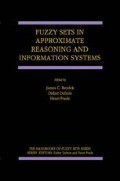Abstract
In accordance with Tarski point of view, in this chapter the theory of closure operators is proposed as a unifying tool for fuzzy logics. Indeed, let F be the set of formulas of a given language. Then an abstract fuzzy logic is defined by a fuzzy semantics (i.e. a class of valuations of the formulas in F) and by a closure operator in the lattice of the fuzzy subsets of F (we call deduction operator). One proves that Pavelka’s logic, similarity logic and graded consequence theory can be represented in this way.
Access this chapter
Tax calculation will be finalised at checkout
Purchases are for personal use only
Preview
Unable to display preview. Download preview PDF.
References
Biacino L. (1993). Generated envelopes, Journal of Math. Anal. Appl., 172, 179–190.
Biacino L. and Gerla G. (1984). Closure systems and L-subalgebras, Information Sciences, 32, 181–195.
Biacino L. and Gerla G. (1992). Generated necessities and possibilities, International Journal of Intelligent Systems, 7, 445–454.
Biacino L. and Gerla G. (1996). An extension principle for closure operators, J. of Math. Anal. Appl., 74, 432–440.
Biacino L. and Gerla G. (1998). Logics with approximate premises, International J. of Intell. Syst., 13, 1–10.
Biacino L. and Gerla G. and Ying M.S. (1998). Approximate reasoning based on similarity, submitted.
Brown D.J. and Suszko R. (1973). Abstract Logics, Dissertationes Mathematicae, 102, 9–42.
Chang C.C. and Keisler H. J. (1966). Continuous Model Theory, Princeton, Princeton University Press.
Chakraborty M.K. (1988). Use of fuzzy set theory in introducing graded consequence in multiple valued logic, in Fuzzy Logic in Knowledge-Based Systems, Decision and Control, MM. Gupta and T. Yamakawa (eds), North-Holland, Amsterdam, 247–257.
Chakraborty M.K. (1995). Graded consequence: further studies. Journal of Applied non-classical Logic, 5 227–237.
Conrad F. (1980). Fuzzy topological concepts, J. Math. Anal. Appl., 74, 432–440.
Dubois D. and Lang J. and Prade H. (1994). Possibilistic logic, In: D. Gabbay, C. Hogger and J. Robinson (eds.) Handbook of Logic in Artificial Intelligence and Logic Programming, vol. 3. Clarendon Press.
Dubois D. and Prade H. (1987). Necessity measures and the resolution principle, IEEE Trans. Systems Man and Cybernetics, 17, 474–478.
Dubois D. and Prade H. (1988). Possibility Theory, Plenum Press, New York and London.
Dubois D., Esteva F., Garcia P., Godo L and Prade H. (1997). A Logical Approach to Interpolation Based on Similarity Relations, Int. J. Approximate Reasoning, 17, 1–36.
Esteva F., Garcia P., Godo L. and Rodriguez R. (1997). A Modal Account of Similarity-Based Reasoning, Int. J. Approximate Reasoning, 16, 235–260.
Ferrante F., Gerla G. and Sessa I. M. (1998). Similarity-based Unification, submitted.
Gerla G. (1994). An extension principle for fuzzy logics, Mathematical Logic Quarterly, 40, 357–80.
G. Gerla (1998). Closure operators, fuzzy logic and constraints, to appear on the book Fuzzy Sets, Logics, and Knowledge-Based Reasoning.
Gerla G. (1996). Closure operators, fuzzy logic and constraints, to appear in Fuzzy Sets, Logics and Reasoning about knowledge.
Gerla G. (1997). Graded consequence relations and closure operators, Journal of Applied non-classical Logic, 6, 369–379.
Gerla, G. (1997), Probability-like functionals and fuzzy logic, J. of Math. Anal. Appl., 216, 438–465.
Gerla G. and Scarpati L. (1998). Extending the extension principles, Inf. Sciences, 106, 49–69.
Goguen J.A. (1968/69). The logic of inexact concepts, Synthese, 19, 325–373.
Murali V. (1991). Lattice of fuzzy subalgebras and closure systems in Ix, Fuzzy Sets and Systems, 41, 101–111.
Negoita C.V. and Ralescu D.A. (1975). Representation theorems for fuzzy concepts, Kybemetes, 4, 169–174.
Pavelka J. (1979). On fuzzy logic I: Many-valued rules of inference, Zeitschr. f. math. Logik und Grundlagen d. Math., Bd.25, 45–52.
Ramik J. (1983). Extension principle and fuzzy-mathematical programming, Kybernetika, 19, 513–25.
Tarski A. (1956). Logic, semantics and metamathematics, Clarendon Press, Oxford.
Ward M. (1942). The closure operators of a lattice, Annals of Mathematics, 43, 191–196.
Ying M.S. (1994). A logic for approximate reasoning, The Journal of Symbolic Logic, 59, 830–837
Zadeh L.A. (1965). Fuzzy Sets, Information and Control, 12, 338–353.
Zadeh, L.A. (1975). Fuzzy logic and approximate reasoning, Synthese, 30, 407–428.
Author information
Authors and Affiliations
Editor information
Editors and Affiliations
Rights and permissions
Copyright information
© 1999 Springer Science+Business Media New York
About this chapter
Cite this chapter
Biacino, L., Gerla, G. (1999). Closure Operators in Fuzzy Set Theory. In: Bezdek, J.C., Dubois, D., Prade, H. (eds) Fuzzy Sets in Approximate Reasoning and Information Systems. The Handbooks of Fuzzy Sets Series, vol 5. Springer, Boston, MA. https://doi.org/10.1007/978-1-4615-5243-7_4
Download citation
DOI: https://doi.org/10.1007/978-1-4615-5243-7_4
Publisher Name: Springer, Boston, MA
Print ISBN: 978-1-4613-7390-2
Online ISBN: 978-1-4615-5243-7
eBook Packages: Springer Book Archive

